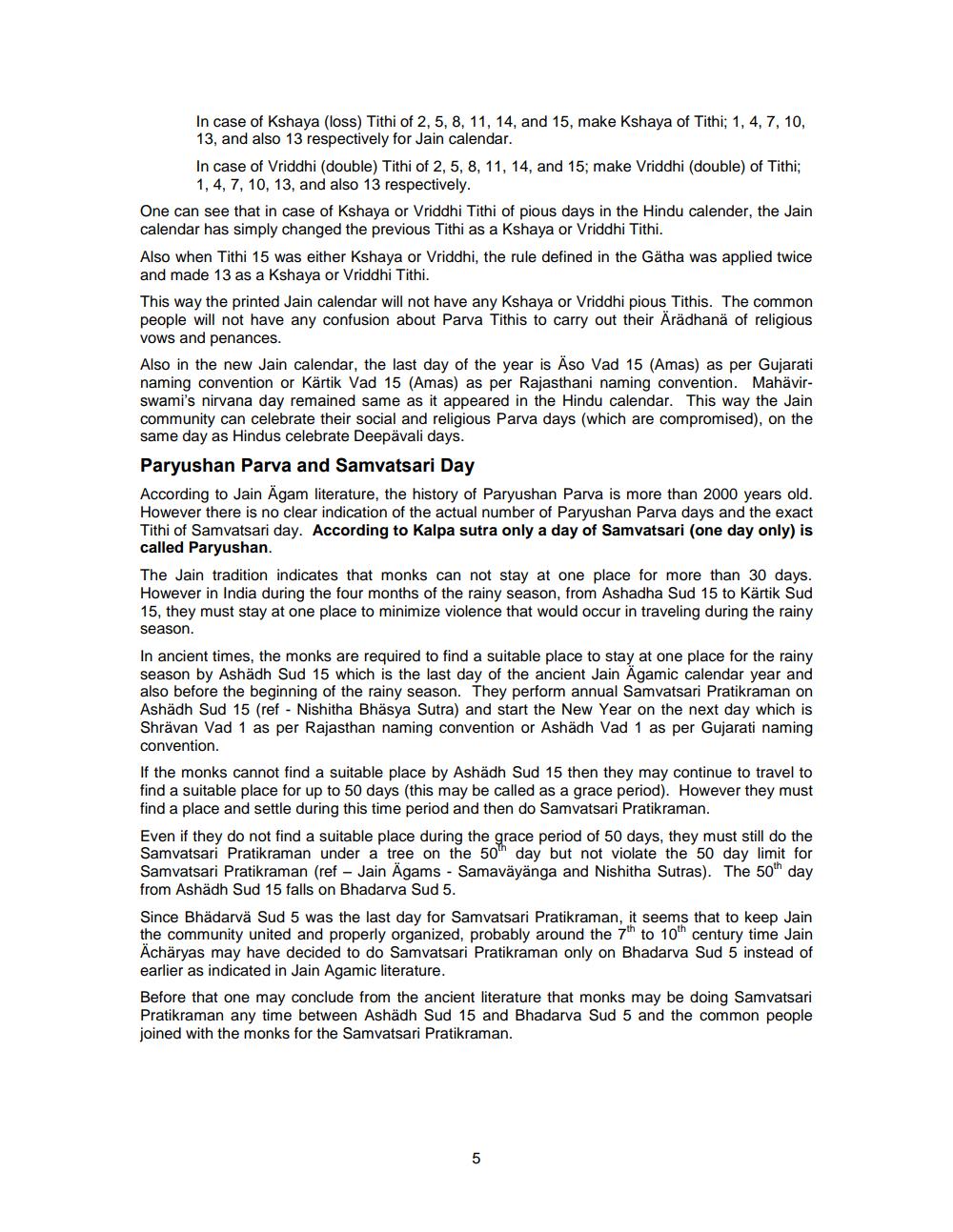Book Title: Samvatsari Tithi Article V4 20120905 Author(s): Pravin K Shah Publisher: JAINA Education Committee View full book textPage 5
________________ In case of Kshaya (loss) Tithi of 2, 5, 8, 11, 14, and 15, make Kshaya of Tithi; 1, 4, 7, 10, 13, and also 13 respectively for Jain calendar. In case of Vriddhi (double) Tithi of 2, 5, 8, 11, 14, and 15; make Vriddhi (double) of Tithi; 1, 4, 7, 10, 13, and also 13 respectively. One can see that in case of Kshaya or Vriddhi Tithi of pious days in the Hindu calender, the Jain calendar has simply changed the previous Tithi as a Kshaya or Vriddhi Tithi. Also when Tithi 15 was either Kshaya or Vriddhi, the rule defined in the Gatha was applied twice and made 13 as a Kshaya or Vriddhi Tithi. This way the printed Jain calendar will not have any Kshaya or Vriddhi pious Tithis. The common people will not have any confusion about Parva Tithis to carry out their Aradhana of religious vows and penances. Also in the new Jain calendar, the last day of the year is Aso Vad 15 (Amas) as per Gujarati naming convention or Kärtik Vad 15 (Amas) as per Rajasthani naming convention. Mahävirswami's nirvana day remained same as it appeared in the Hindu calendar. This way the Jain community can celebrate their social and religious Parva days (which are compromised), on the same day as Hindus celebrate Deepavali days. Paryushan Parva and Samvatsari Day According to Jain Agam literature, the history of Paryushan Parva is more than 2000 years old. However there is no clear indication of the actual number of Paryushan Parva days and the exact Tithi of Samvatsari day. According to Kalpa sutra only a day of Samvatsari (one day only) is called Paryushan. The Jain tradition indicates that monks can not stay at one place for more than 30 days. However in India during the four months of the rainy season, from Ashadha Sud 15 to Kärtik Sud 15, they must stay at one place to minimize violence that would occur in traveling during the rainy season. In ancient times, the monks are required to find a suitable place to stay at one place for the rainy season by Ashädh Sud 15 which is the last day of the ancient Jain Agamic calendar year and also before the beginning of the rainy season. They perform annual Samvatsari Pratikraman on Ashädh Sud 15 (ref - Nishitha Bhäsya Sutra) and start the New Year on the next day which is Shrävan Vad 1 as per Rajasthan naming convention or Ashädh Vad 1 as per Gujarati naming convention. If the monks cannot find a suitable place by Ashädh Sud 15 then they may continue to travel to find a suitable place for up to 50 days (this may be called as a grace period). However they must find a place and settle during this time period and then do Samvatsari Pratikraman. Even if they do not find a suitable place during the grace period of 50 days, they must still do the Samvatsari Pratikraman under a tree on the 50th day but not violate the 50 day limit for Samvatsari Pratikraman (ref - Jain Agams - Samaväyänga and Nishitha Sutras). The 50 day from Ashädh Sud 15 falls on Bhadarva Sud 5. Since Bhädarvä Sud 5 was the last day for Samvatsari Pratikraman, it seems that to keep Jain the community united and properly organized, probably around the 7 to 10" century time Jain Acharyas may have decided to do Samvatsari Pratikraman only on Bhadarva Sud 5 instead of earlier as indicated in Jain Agamic literature. Before that one may conclude from the ancient literature that monks may be doing Samvatsari Pratikraman any time between Ashädh Sud 15 and Bhadarva Sud 5 and the common people joined with the monks for the Samvatsari Pratikraman.Page Navigation
1 ... 3 4 5 6 7 8 9 10
